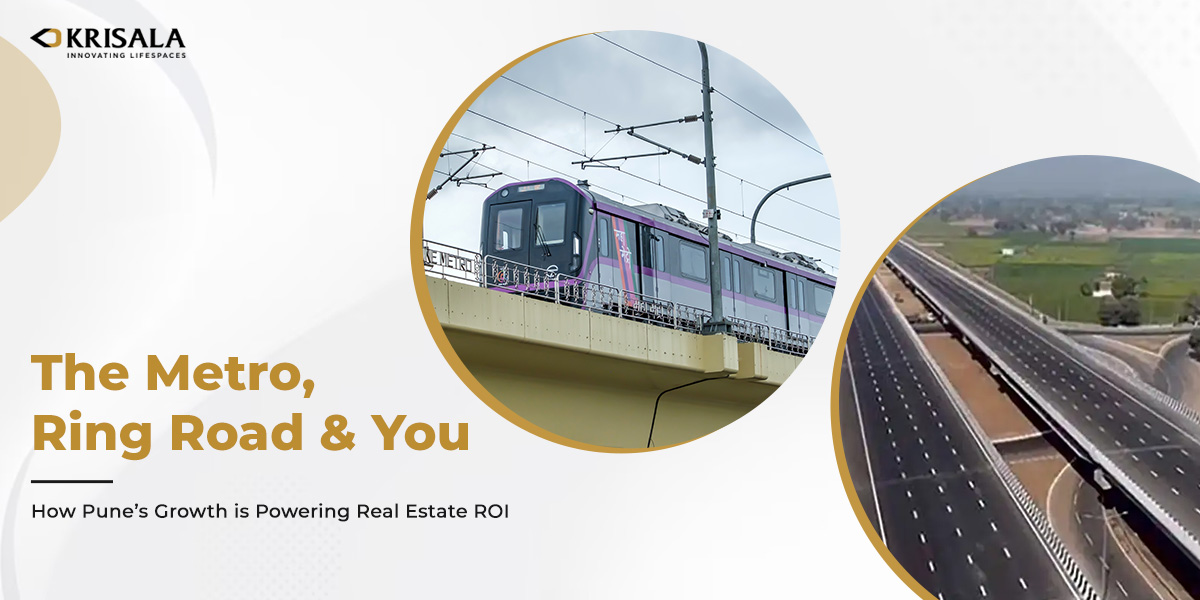
The Metro, Ring Road & You: How Pune’s Growth is Powering Real Estate ROI
Pune Is Expanding – But the Smart Money Follows the Roads
In 2010, many homebuyers hesitated when properties in Hinjawadi were priced at Rs. 25-30 lakhs for a 2 BHK. The area was still developing, and some thought it was too far from the city core. Fast forward to 2025 – those same properties are now valued at Rs. 80 lakhs to Rs. 1 crore, and the area has transformed into Pune’s IT powerhouse. For those who missed out, the lesson is clear: real estate growth follows infrastructure – not the other way around.
Today, a similar opportunity is unfolding.
Pune 2025: A City in Hyper-Growth Mode
- GDP Growth: Pune continues to be one of India’s fastest-growing urban economies, with strong momentum in IT, auto, and manufacturing sectors driving sustained GDP growth through 2030.
- Population: Over 7.4 million residents in 2025 (PMC + PCMC), with consistent inflow from Tier 2 cities and other states.
- Employment Engine: Pune is home to hundreds of IT and tech-enabled companies, ranging from global giants to agile startups, making it one of India’s top 3 IT hubs alongside Bengaluru and Hyderabad.
This growth has fuelled massive demand for housing – but smart investors know location isn’t enough. It’s about where the roads and rails lead next.
Infrastructure Is the New Investment Compass
In a city expanding rapidly, connectivity is currency. And in Pune, the Ring Road and Metro network are the two most valuable “currencies” right now.
- The Ring Road will completely redefine suburban access, making now-remote zones prime real estate in the next 2-3 years.
- The Metro is reducing commute stress, boosting liveability scores, and raising land values near stations.
Together, they’re creating a new map of ROI opportunities that savvy investors are already tracking.
Pune Ring Road: The 173 – KM Expressway Reshaping Investment Geography
The Pune Ring Road isn’t just another infrastructure upgrade – it’s a blueprint for how Pune will expand, evolve, and attract investment over the next decade. Designed to ease congestion and open new corridors of connectivity, this 173-km expressway is already redrawing the city’s real estate heatmap.
Key Project Details
| Feature | Details |
| Total Length | Approx. 173 km, full loop (outer and connecting arms) |
| Road Type | 8-lane expressway (6 main lanes + 2 service lanes planned) |
| Phases | Divided into 4 Phases (Theur–Wagholi, Wagholi–Chimbli, Chimbli–Pirangut, Pirangut–Theur) |
| Agencies | Executed by MSRDC; planning coordinated with PMRDA |
| Timeline | Construction began in late 2024; full completion projected by 2030 |
| Land Acquisition | ~90% acquired for western stretches; ongoing in eastern regions |
| Highways Connected | NH-48, NH-60, NH-65, NH-753F, NH-965 |
Why It Matters to Real Estate
The Ring Road isn’t just a commute shortcut — it’s an urban rebalancing tool that will:
- Divert intercity freight & heavy vehicles, making core roads safer and faster for daily commuters.
- Improve connectivity across Pune’s periphery, especially areas like Wagholi, Theur, Chimbli, Pirangut, and key suburbs like Hinjawadi, Wakad, Punawale, and Tathawade.
- Boost job corridors through proposed logistics parks, industrial zones, and warehousing hubs.
- Unlock housing demand in what were once low-density, underdeveloped areas.
Bottom Line for Investors
- Areas along the Ring Road are already witnessing early project announcements, land value shifts, and developer traction.
- Future-ready buyers and institutional investors are targeting these corridors for mid- to long-term capital gains.
- Infrastructure-led appreciation is not speculative — it’s a trend already seen in Hyderabad (Outer Ring Road), Bengaluru (Peripheral Ring Road), and now unfolding in Pune.
Pune Metro: Fast Tracks That Unlock New Investment Zones
Pune’s Metro network is more than a public transport initiative – it’s a powerful economic engine reshaping how the city lives, works, and invests. As lines go live and new phases unfold, we’re already seeing a ripple effect on real estate values, rental yields, and investor interest. If the Ring Road is Pune’s horizontal expansion story, the Metro is its vertical catalyst – connecting the dots of convenience, employment, and real estate appreciation.
Operational Lines: Already Making a Difference
Purple Line (Line 1): Runs from PCMC to Swargate, with key stations like Pimpri, Kasarwadi, Shivajinagar, and Civil Court. The full line became operational in September 2024, connecting Pune’s industrial belt with the city center.
Aqua Line (Line 2): Connects Vanaz to Ramwadi, passing through Kothrud, Nal Stop, Deccan Gymkhana, Yerawada, and other east-west transit corridors. This line has been fully operational since August 2023, significantly reducing east-west commute times.
By 2025, both lines are experiencing strong ridership and improving last-mile connectivity across residential and employment hubs.
Lines to Watch in 2025-2026
| Line | Route | Status | Key Highlights |
| Line 3 | Hinjawadi to Shivajinagar | Under construction (85% complete) | 23.3 km elevated corridor with 23 stations; connects IT hub to city core. Launch delayed to 2026. |
| Line 1B | Swargate to Katraj | Approved; construction underway | 5.46 km underground extension; 3 stations: Market Yard, Padmavati, Katraj. Added stations causing minor delays. |
| Line 4 | Civil Court to Loni Kalbhor | DPR prepared; planning phase | Proposed 18 km corridor; awaits Phase 2 inclusion and final approvals. |
| Line 5 | Khadakwasla to Kharadi | Approved; in planning/tendering stage | 25.5 km route with 22 stations; to pass via Swargate and Hadapsar. Approved in 2024. |
- Line 3 is a major development for Pune’s tech corridor – it directly connects Hinjawadi IT Park to central business zones, reducing travel time by 40-60%.
- Lines 4 & 5 are aimed at connecting Pune’s educational, residential, and future urban expansion zones.
Metro = Micro-Market Multiplier
The presence of a metro station near a property isn’t just a convenience – it’s an economic upgrade. Studies and patterns from Delhi, Bangalore, and now Pune show:
- Property values within 1-1.5 km of a metro station typically see a 15-30% appreciation once operations begin.
- Rental returns in metro-accessible neighborhoods are 3-4% higher compared to non-connected areas.
- Foot traffic and retail potential rise, making such zones attractive not only for homebuyers but also for commercial investors.
Case Study: PCMC & Pimpri Metro Zones
- When the Purple Line opened, areas like Pimpri and Kasarwadi saw an 8-12% increase in apartment prices over the next year.
- Nearby rental demand surged, particularly from young IT professionals, government employees, and students.
So, Where Should You Invest? Follow the Infrastructure Trail
Pune’s infrastructure revolution is already redrawing the city’s real estate map. With the Metro and Ring Road projects rapidly progressing, investors are shifting focus to zones directly impacted by these upgrades – not just traditional hotspots.
Areas like Punawale, Hinjawadi (Phase 2/3), Wakad, and Tathawade are no longer “emerging” – they’re being transformed by infrastructure into tomorrow’s prime locations. These micro-markets offer a powerful mix of:
- Proximity to Metro Line 3
- Direct or peripheral access to the Pune Ring Road
- Smart housing formats, growing lifestyle infrastructure, and increasing rental demand
And the results are already visible:
- Faster sales velocity
- Early investor entry
- Rising land and apartment values
What Smart Investors Are Doing Right Now
Across these micro-markets, we’re seeing clear shifts in buyer behavior – the kind that typically foreshadows a real estate wave.
- NRIs are buying second homes in Metro-linked areas, locking in rental returns before the appreciation wave hits.
- Gen Z professionals want walk-to-work or walk-to-metro convenience, driving demand for 1.5-2 BHK compact lifestyle homes.
- Plot buyers are switching strategies – selling undeveloped land and reinvesting in apartment units that offer faster ROI and guaranteed rental income.
How Krisala Developers is Aligning with the Future
While many developers are still reacting to Pune’s growth, Krisala Developers is already building ahead of it.
We’ve strategically positioned our latest projects in high-potential, infrastructure-forward zones – areas aligned with the upcoming Metro routes and Ring Road corridors that are set to drive real estate appreciation for the next decade.
Our Projects in the Growth Belt
| Project | Location | Infra Advantage |
| 41 Zillenia Phase 2 | Punawale | Near Ring Road + forest-facing homes |
| Zoy + | Hinjawadi | Proximity to Metro Line 3 (Hinjawadi Route) |
| 41 Commune | Wakad | Ring Road + Metro access in a high-demand suburb |
These are not speculative launches – they’re smartly placed, future-proofed communities designed for long-term value growth, rental yield, and superior liveability.
The Window Is Narrow – Here’s Why You Should Act Now
The best infrastructure-led gains don’t wait.
With Metro Line 3 nearing completion and Ring Road construction already underway, the price climb has already begun in Pune’s growth zones. The opportunity isn’t in the future – it’s right now, and it’s quickly slipping through the fingers of those who delay.

